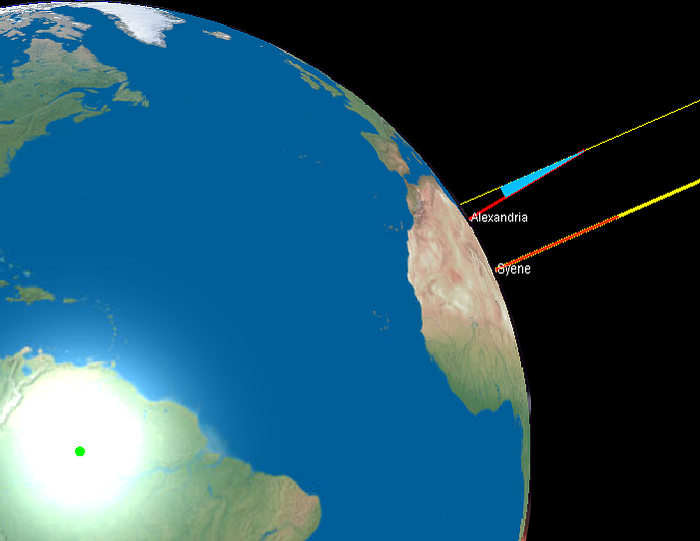Eratosthenes: The Ancient Mathematician Who Measured the Earth
Written on
Chapter 1: The Dawn of the Space Age
In the mid-20th century, humanity entered the space age, launching satellites to orbit Earth for enhanced measurement and mapping. This advancement allowed us to arrive at a remarkably precise estimate of the Earth's circumference, approximately 40,075 kilometers at the equator. Yet, astonishingly, this knowledge was already uncovered by the ancient mathematician Eratosthenes of Cyrene over two millennia prior.
Eratosthenes was born in 276 BC in Cyrene, modern-day Libya. His educational journey began in his hometown before he traveled to Athens for further studies. He authored works spanning various fields, including science, poetry, and music theory. His growing reputation led Pharaoh Ptolemy III Euergetes to appoint him as the chief librarian of the prestigious Library of Alexandria. In 245 BC, Eratosthenes accepted this significant role in Alexandria, where he would spend the remainder of his life.
Section 1.1: The Curiosity of Eratosthenes
Eratosthenes became particularly intrigued by reports that in Syene, located south of Alexandria, vertical objects cast no shadows at noon during the summer solstice. A well in Syene was entirely illuminated by the sun at this time, suggesting that the sun was directly overhead. This sparked Eratosthenes’ curiosity. He decided to test whether a vertical stick in Alexandria would cast a shadow at the same moment.
On June 21, 240 BC, he planted a stick upright in Alexandria. To his surprise, it did cast a shadow, measuring about 1/50 of 360 degrees from vertical, approximately 7 degrees. Eratosthenes correctly assumed that the sun's rays, coming from a great distance, were arriving at both locations at the same angle. This observation led him to conclude that the Earth must be curved.
Subsection 1.1.1: The Experiment

Eratosthenes recognized that the difference in shadow length indicated a curvature in the Earth's surface. This idea was not entirely new; Pythagoras and Aristotle had previously speculated about Earth's spherical nature. However, Eratosthenes provided the first scientific evidence for this hypothesis using a simple stick and some logical reasoning.
Section 1.2: Calculating the Circumference
Eratosthenes then set out to determine the Earth's size. He envisioned creating a map of the world, but first needed to understand its scale. By drawing two lines through the locations of his sticks in Alexandria and Syene, he theorized that they would converge at the center of the Earth, forming an angle, θ.
Through geometric reasoning, he established that if the angle between the two cities was θ, and the distance between them was known, he could calculate the Earth's circumference. Eratosthenes hired a surveyor who reported the distance between Alexandria and Syene as 5,000 stadia, roughly 800 kilometers.
This set the stage for his calculation:
800 / x = 1/50 => x = 800 × 50 = 40,000 km.
He concluded that not only was the Earth round, but he also estimated its circumference with remarkable accuracy, achieving this without ever leaving Egypt.
Chapter 2: The Legacy of Eratosthenes
In this video, we explore how Eratosthenes calculated the Earth's circumference using clever observation and mathematics.
Eratosthenes' accomplishments did not end there. By observing the sun's trajectory, he estimated the tilt of the Earth to be about 23.5 degrees, a figure that also holds true today and accounts for the seasons we experience.
Mathematical Explorations in Science
Eratosthenes' story is not unique. In the 17th century, Isaac Newton developed calculus to decipher planetary motions, a foundational achievement in science that still influences our understanding of the universe today.
Later, the mysteries surrounding Mercury's orbit led to the groundbreaking work of Albert Einstein. His theories of relativity transformed our understanding of time and space, revealing a complex interplay between matter and gravitational forces.
Einstein's insights, coupled with Eratosthenes' early calculations, highlight the power of mathematics as a tool for exploring the natural world.
Is Our Planet Really a Sphere?
The Earth is not a perfect sphere; its shape is more accurately described as an ellipsoid due to its rotation, with a circumference of about 40,007 km at the poles. Variations in gravity and geological features further complicate its shape, leading to a dynamic surface shaped by forces in play since the solar system's formation.
In summary, while Eratosthenes may not have fully grasped all the intricacies of gravity and Earth's shape, his mathematical reasoning laid the groundwork for future explorations into our planet and beyond.
In this video, we delve into how the Ancient Greeks, including Eratosthenes, calculated the size of the Earth using observational techniques.